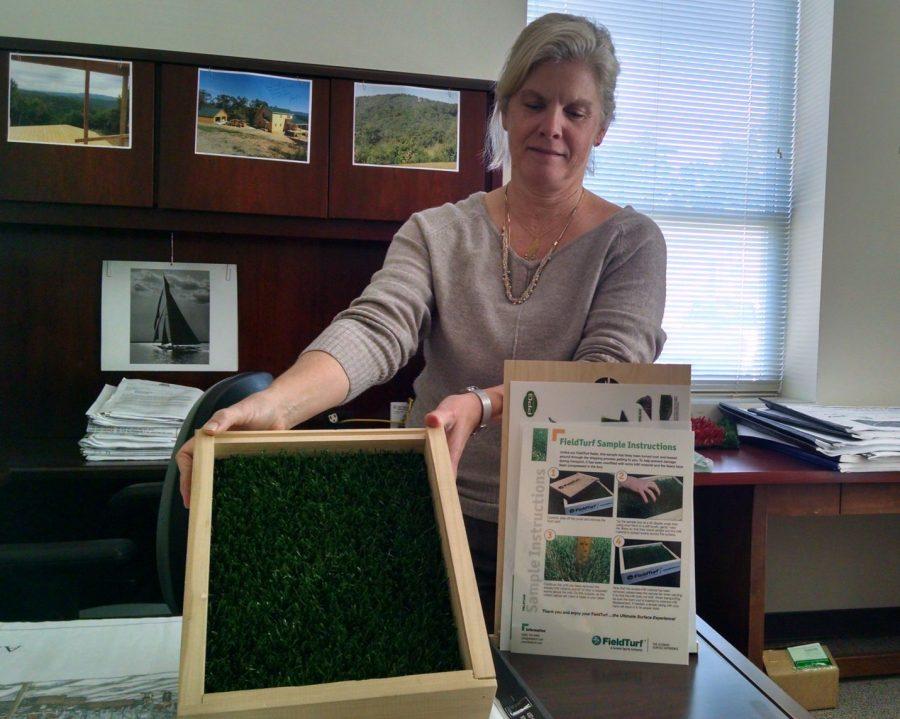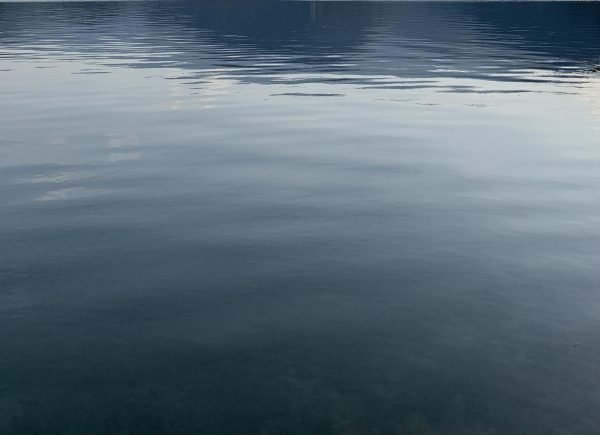UNCW’s impending decision to install artificial turf could have cancerous effects
Facilities Structural Engineer Lisa Seifert displays a sample of artificial turf that UNCW is considering using for the installation of two oversized turf soccer fields in the intramural area on campus.
UNC Wilmington is considering installing artificial turf with rubber crumb infill on its own athletic fields just as three federal agencies have launched investigations to evaluate cancer risks associated with exposure to tire crumb used as infill in artificial turf, according to a Feb. 12, 2016 NBC news report.
The investigations by the EPA, Consumer Product Safety Commission and Centers Disease Control and Prevention were prompted in part by former United States women’s national soccer team goalkeeper and current University of Washington goalkeeper coach Amy Griffin, who compiled a list of 200 athletes who had played on tire crumb synthetic turf and had been diagnosed with cancer, according to a November 2015 ESPN article by Julie Foudy.
“I kept asking people, ‘Don’t you guys think it’s weird?’ Does someone think it’s weird that all these goalkeepers have cancer … and there are only one or two per team?” Griffin told ESPN.
Out of the 200 athletes listed as affected by artificial turf, 101 were goalkeepers — players who came into contact with tire crumb more than any other position, Griffin said.
The federal investigations begin as UNCW considers the use of tire crumb for the installation of two artificial turf soccer fields in the campus intramural area, according to officials in UNCW’s Department of Architecture and Construction Services.
Tire crumb is the black infill that pads between the artificial grass of the turf; it provides impact resistance and increases players’ mobility, said Director of Architectural and Construction Services Mark Morgan.
This infill is composed of scrap car and truck tires that are ground up and recycled, according to the Synthetic Turf Council, a nonprofit organization that is sponsored by two national turf corporations.
Officials in charge of the initial field plans were aware of the health concerns associated with the tire rubber, Morgan said, but since a conclusive causal relationship has yet to be proven, since there is no legislation in place regarding the use of the tire crumb and tire crumb is more cost-effective, university officials have continued to consider using the infill.
But UNCW is contemplating using an alternative to the tire crumb padding: coated silica sand, which is both non-toxic and sealed from bacteria, according to the Synthetic Turf Council. However, Morgan said that this alternative could cost UNCW an estimated additional $200,000-300,000.
Funding was secured for the $2.5 million intramural field renovation project in 2008, years before the execution of building plans were set in motion, making it difficult to work around the unexpected health concern of tire crumb rubber, Morgan said.
“The decision [to use tire crumb use or a less disconcerting alternatives like silica sand] may come down to the dollars and cents,” said Morgan.
The final resolution will be left up to the Board of Trustees, who approved the $2.5 million original budget for the fields in December 2013, said Morgan. It will be in consensus with Student Affairs and Business Affairs, as well as other UNCW offices. Morgan said that outside resources may be brought in if expert opinions are necessary.
The chemicals found in tire crumb that cause problems include benzothiazole, a skin and eye irritant; butylated hydroxyanisole, a recognized carcinogen; and 4-tert-octylphenol, which is destructive to mucous membranes.
All of these chemicals have been identified by nonprofit Environment and Human Health, Inc. and raise concerns about the environmental safety of these fields. But no one can verify what the recycled tire material can contain, Morgan said.
“The existing studies do not comprehensively evaluate the concerns about health risks from exposure to tire crumb,” said the CPSC in its 2016 Federal Research Action Plan on Recycled Tire Crumb.
The federal organization anticipates releasing a status report with ‘preliminary findings’ by the end of 2016, it says in the report, but that will likely be after the installation of the turf fields.
But maintaining natural grass intramural fields poses its own set of hazards because of the use of herbicides and fertilizers, the disposal of cut grass and the runoff due to the less permeable soil, Morgan said.
A new study by the University of Rhode Island could show that there are no measurable differences between athletic performance on artificial turf or on natural grass, said Associate Professor of Exercise Science Dr. Disa Hatfield, who is heading the study, “The Effects of Different Athletic Playing Surfaces on Jump Height, Force, and Power,” which is slated to be released within the next month.
“Performance is pretty much the same across all surfaces,” said Dr. Hatfield. The results of her study will not be conclusive or revelatory of injury concerns, she says, because conclusive data is hard to come by due to the many variables involved with testing on humans.
Nevertheless, in the opinion of UNCW students, the use of this rubber infill might be worthwhile.
“They’re more fun to play on,” UNCW sophomore and recreational soccer player Cody Jennings said. “They’re not going to be patchy. They’re even.”
Also remarking on the safety of this project, UNCW SGA Nontraditional Senator Steven Nunez said “I have always been wary of turf and the injury implications that it brings.”
UNCW will need to weigh the initial monetary savings of using the less expensive tire crumb against the potential hazard of the suspected carcinogens in the infill.
“There is a need for artificial fields so we can give you guys [UNCW Students] playing time,” Director Morgan said. “But we [UNCW] don’t want to do that as a hazard.”
*CORRECTION: The original article published Thursday, Feb. 25, 2016 pertaining to UNCW’s potential decision to install artificial turf on the athletic fields inaccurately stated the SGA’s opinion on the matter. The SGA did not give their opinion on the subject of the rubber infill use.








